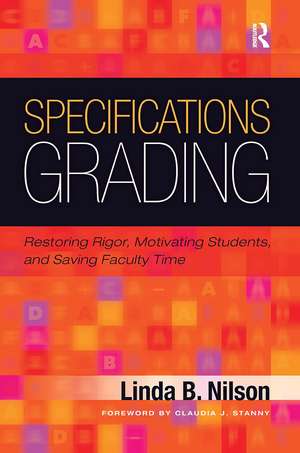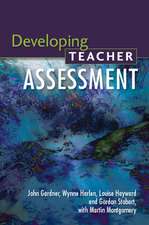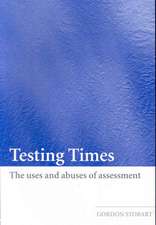Specifications Grading: Restoring Rigor, Motivating Students, and Saving Faculty Time
Autor Linda B. Nilsonen Limba Engleză Paperback – 22 oct 2014
| Toate formatele și edițiile | Preț | Express |
|---|---|---|
| Paperback (1) | 213.82 lei 6-8 săpt. | |
| Taylor & Francis – 22 oct 2014 | 213.82 lei 6-8 săpt. | |
| Hardback (1) | 997.27 lei 6-8 săpt. | |
| Taylor & Francis – 22 oct 2014 | 997.27 lei 6-8 săpt. |
Preț: 213.82 lei
Nou
Puncte Express: 321
Preț estimativ în valută:
40.92€ • 42.91$ • 34.06£
40.92€ • 42.91$ • 34.06£
Carte tipărită la comandă
Livrare economică 01-15 aprilie
Preluare comenzi: 021 569.72.76
Specificații
ISBN-13: 9781620362426
ISBN-10: 1620362422
Pagini: 184
Dimensiuni: 152 x 229 x 15 mm
Greutate: 0.27 kg
Ediția:1
Editura: Taylor & Francis
Colecția Routledge
Locul publicării:Oxford, United Kingdom
ISBN-10: 1620362422
Pagini: 184
Dimensiuni: 152 x 229 x 15 mm
Greutate: 0.27 kg
Ediția:1
Editura: Taylor & Francis
Colecția Routledge
Locul publicării:Oxford, United Kingdom
Public țintă
Postgraduate and Professional Practice & DevelopmentCuprins
FOREWORD Claudia J. Stanny PREFACE ACKNOWLEDGMENTS 1. THE NEED FOR A NEW GRADING SYSTEM 2. LEARNING OUTCOMES AND COURSE DESIGN 3. LINKING GRADES TO OUTCOMES 4. PASS/FAIL GRADING FOR RIGOR, MOTIVATION, AND FACULTY PEACE OF MIND 5. ESSENTIALS OF SPECIFICATIONS GRADING 6. CONVERTING SPECS-GRADED STUDENT WORK INTO FINAL LETTER GRADES 7. EXAMPLES OF SPECS-GRADED COURSE DESIGNS 8. THE MOTIVATIONAL POWER OF SPECS GRADING 9. DEVELOPING A COURSE WITH SPECS GRADING 10. AN EVALUATION OF SPECS GRADING REFERENCES ABOUT THE AUTHOR INDEX
Notă biografică
Linda B. Nilson is founding director emeritus of the Office of Teaching Effectiveness and Innovation (OTEI) at Clemson University and author of Teaching at Its Best: A Research-Based Resource for College Instructors, now in its fourth edition. Claudia J. Stanny is the Director, Center for University Teaching, Learning, and Assessment, and Associate Professor, Department of Psychology, University of West Florida
Recenzii
“As an undergraduate, I often thought, ‘After this course is over, I will learn the material,’ feeling that traditional grading got in the way of my learning. Specifications Grading offers a practical alternative that increases student motivation to learn, self-direction, and mastery, while reducing grading time, grade grubbing, and student anger at constructive criticism. With myriad examples throughout, Specs Grading demonstrates how to make grading learning-centered, aligned with student-achieved learning outcomes, and civil.”
Cynthia G. Desrochers
Professor of Education, Founding Director, Faculty Development Center, California State University, Northridge
“Linda Nilson has created a compelling and inclusive justification for how we got to where we are and what does not work with our current approach to grading. She paints a promising vision for our pathways into a future in which learning can become the real measure of academic currency.”
Sally M. Johnstone, Vice President for Academic Advancement
Western Governors University
"What a ridiculously simple yet profound plan for achieving what Nilson purports. Imagine, students demonstrating mastery of skill for a grade! Students taking back ownership of their progress! Students becoming our clients rather than our customers! Specs Grading, get ready to sashay in and partner up with the outcomes that grades should really reflect."
Carol Washburn EdD, Senior Instructional Designer, Manager, Teaching & Learning
Center for Instructional Development & Distance Education, University of Pittsburgh
"This book will change your life! Every instructor should buy it now. Nilson shows us how to make grading easier, more logical, and more consonant with research on learning and motivation. A practical, time-saving, student-motivating system of grading. A major advance in our thinking about how we grade and how students learn."
Barbara Walvoord
Professor Emerita, University of Notre Dame
“Faculty who struggle with the challenges of managing time for grading student work and collecting meaningful assessment data from assignments and projects embedded in their courses will find much to interest them in Specifications Grading. Nilson proposes a new approach to rubrics that simplifies the task of grading, maintains standards for consistency and validity of assessments, and aligns grades with specific learning outcomes.
Specifications grading addresses a question that has long puzzled faculty: Why aren’t the grades earned by students accepted as assessments of student learning?
Nilson presents models for grading assignments and models for combining assignments within a course to document the degree to which students attain competencies expected of all students in the course. She describes class grading structures that enable faculty to create learning-centered learning environments that motivate students, document student attainment of intended learning outcomes, and generate a traditional range of grades to recognize and document the achievements of students who exceed learning expectations for the course.”
Claudia J. Stanny
Director, Center for University Teaching, Learning, and Assessment, and Associate Professor, Department of Psychology, University of West Florida
"Time is precious, and achieving high academic standards is essential for our students. Linda Nilson has given us a thorough review of grading practices and created spec grading, which holds promise both for saving some time for faculty and students and for elevating our standards for student learning outcomes. Brava!"
Trudy W. Banta, Professor of Higher Education, Senior Advisor to the Chancellor for Academic Planning and Evaluation
Indiana University-Purdue University Indianapolis
“Her latest book, Specifications Grading: Restoring Rigor, Motivating Students, and Saving Faculty Time, is maybe the most innovative, provocative, and potentially revolutionary one she’s done.
Therefore I’m making a commitment to dropping traditional grading systems cold-turkey and adopting specs grading in both my classes next semester. Those classes are well-suited for this system: a second-semester abstract algebra course, and the second semester of Discrete Structures for Computer Science. I don’t know exactly how it’s going to look yet or how it’s going to work. But I think I need to do this, if I want to have the kind of classes to which I aspire and which I want to provide for my students.”
Robert Talbert, “Casting Out 9s” blog, Chronicle of Higher Education
Cynthia G. Desrochers
Professor of Education, Founding Director, Faculty Development Center, California State University, Northridge
“Linda Nilson has created a compelling and inclusive justification for how we got to where we are and what does not work with our current approach to grading. She paints a promising vision for our pathways into a future in which learning can become the real measure of academic currency.”
Sally M. Johnstone, Vice President for Academic Advancement
Western Governors University
"What a ridiculously simple yet profound plan for achieving what Nilson purports. Imagine, students demonstrating mastery of skill for a grade! Students taking back ownership of their progress! Students becoming our clients rather than our customers! Specs Grading, get ready to sashay in and partner up with the outcomes that grades should really reflect."
Carol Washburn EdD, Senior Instructional Designer, Manager, Teaching & Learning
Center for Instructional Development & Distance Education, University of Pittsburgh
"This book will change your life! Every instructor should buy it now. Nilson shows us how to make grading easier, more logical, and more consonant with research on learning and motivation. A practical, time-saving, student-motivating system of grading. A major advance in our thinking about how we grade and how students learn."
Barbara Walvoord
Professor Emerita, University of Notre Dame
“Faculty who struggle with the challenges of managing time for grading student work and collecting meaningful assessment data from assignments and projects embedded in their courses will find much to interest them in Specifications Grading. Nilson proposes a new approach to rubrics that simplifies the task of grading, maintains standards for consistency and validity of assessments, and aligns grades with specific learning outcomes.
Specifications grading addresses a question that has long puzzled faculty: Why aren’t the grades earned by students accepted as assessments of student learning?
Nilson presents models for grading assignments and models for combining assignments within a course to document the degree to which students attain competencies expected of all students in the course. She describes class grading structures that enable faculty to create learning-centered learning environments that motivate students, document student attainment of intended learning outcomes, and generate a traditional range of grades to recognize and document the achievements of students who exceed learning expectations for the course.”
Claudia J. Stanny
Director, Center for University Teaching, Learning, and Assessment, and Associate Professor, Department of Psychology, University of West Florida
"Time is precious, and achieving high academic standards is essential for our students. Linda Nilson has given us a thorough review of grading practices and created spec grading, which holds promise both for saving some time for faculty and students and for elevating our standards for student learning outcomes. Brava!"
Trudy W. Banta, Professor of Higher Education, Senior Advisor to the Chancellor for Academic Planning and Evaluation
Indiana University-Purdue University Indianapolis
“Her latest book, Specifications Grading: Restoring Rigor, Motivating Students, and Saving Faculty Time, is maybe the most innovative, provocative, and potentially revolutionary one she’s done.
Therefore I’m making a commitment to dropping traditional grading systems cold-turkey and adopting specs grading in both my classes next semester. Those classes are well-suited for this system: a second-semester abstract algebra course, and the second semester of Discrete Structures for Computer Science. I don’t know exactly how it’s going to look yet or how it’s going to work. But I think I need to do this, if I want to have the kind of classes to which I aspire and which I want to provide for my students.”
Robert Talbert, “Casting Out 9s” blog, Chronicle of Higher Education
Descriere
This book features many examples of courses that faculty have adapted to spec grading and lays out the surprisingly simple transition process. It is intended for all members of higher education who teach, whatever the discipline and regardless of rank, as well as those who oversee, train, and advise those who teach.









